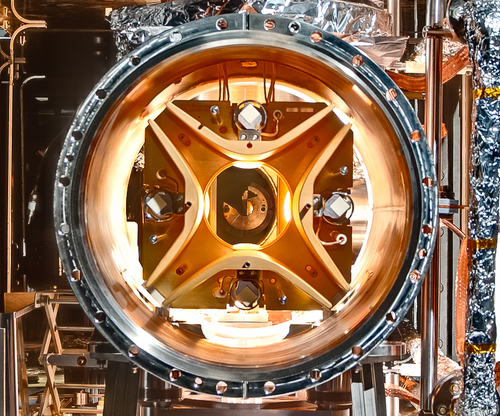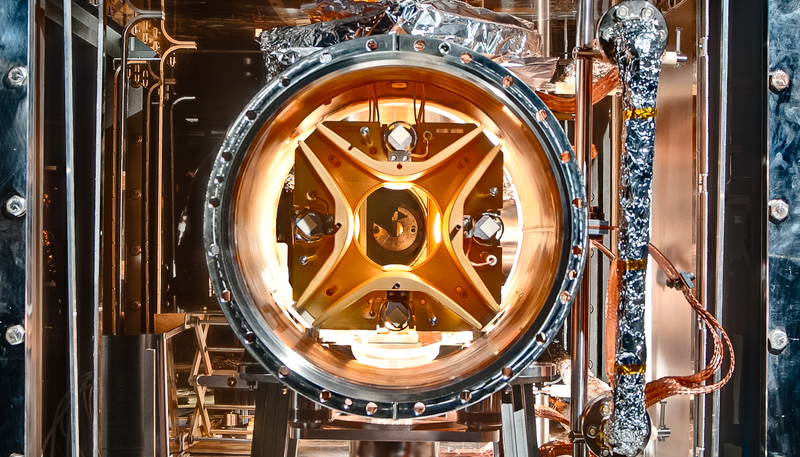The Coolest Molecular Ion Beams
Cooling a beam of molecular ions so that they occupy their lowest-energy quantum state (ground state) would permit high-precision study of their properties and would improve understanding of star-forming gas clouds. Now research teams in Sweden and Germany have accomplished this feat by placing the entire apparatus for trapping and probing molecular ions inside cryogenic cooling systems at temperatures of around 10 degrees above absolute zero. They expect to carry out experiments relevant for astrophysics at a new level of precision.
Reactions between cold atoms, molecules, and ions in interstellar clouds create the material from which stars and planets are made. The states of the molecules involved in these processes can be studied by measuring how the gas absorbs light from more distant stars, but to understand these spectra, researchers need data from laboratory measurements on cold molecules.
Molecular ions can be conveniently trapped by electromagnetic fields in storage rings, but cooling them to interstellar temperatures is challenging. If the ions are warmer, they occupy a mixture of their many vibrational and rotational states, so any measurements are averaged over those states and are hard to interpret. Ideally, researchers could cool them enough that the ions are exclusively in their ground state of rotation and vibration. “Well-defined initial states are essential for the interpretation,” says Henning Schmidt of Stockholm University, co-leader of DESIREE (Double Electrostatic Ion Ring Experiment).
Previous efforts to cool molecular ions have mostly used collisions with surrounding atoms of an inert cold gas such as helium [1]. But for reasons that are still not entirely clear, these methods failed to bring the ion temperature below about 20 K.
Both DESIREE at Stockholm University and CSR (Cryogenic Storage Ring) at the Max Planck Institute for Nuclear Physics in Heidelberg, Germany, are ion storage rings that were built small enough for the entire apparatus to be enclosed within a cryogenically cooled system [2, 3], and both use helium to cool the apparatus. The low temperature—13 K for DESIREE and 6 K for CSR— helps to create an ultrahigh vacuum inside the storage rings, minimizing the chances of ion collisions with any residual gas. In their latest efforts, both teams study hydroxyl ions ( ).
“The major experimental innovation for this work is the construction of cryogenic storage rings,” says Christian Meyer, a University of Heidelberg Ph.D. student working on the CSR experiment. With the cryogenic storage rings, the researchers simply wait until the molecular ions cool to the temperature of their surroundings by spontaneously emitting low-energy photons. “If we leave them long enough, they will get cold,” says Schmidt. Despite the high vacuum, the ions eventually become neutralized by collisions with residual gas molecules, and only about half or fewer are still within the DESIREE ring by the time they have equilibrated (10–15 minutes for ).
Both teams assess the degree of rotational cooling using standard techniques that involve neutralizing ions with laser light, which allows them to escape the electrostatic trapping fields and reach detectors. The energy needed to detach an electron from an ion depends slightly on its rotational state, so by counting the detected molecules while varying the laser frequency, the researchers can determine the populations of rotational states, says Meyer.
Both the CSR and DESIREE teams find that their ions will cool down to about 13–15 K, which is close to (for CSR) or virtually equal to (for DESIREE) the temperature of the cryogenically cooled ring. At this temperature, the vast majority of the ions (90–99%) are in the lowest rotational state. “The molecular temperature is low enough to measure collisions of molecular ions with neutral particles or electrons under interstellar conditions,” says Meyer. “Those processes are important for understanding the chemistry in interstellar clouds.”
The sheer technical achievement of cooling the ions to their lowest rotational state is “the most important result of these papers,” says molecular physicist Klavs Hansen of Tianjin University in China. But Hansen warns that “larger ions may require lower temperatures to reach similar rotational states.” However, says Schmidt, the temperatures currently attained are comparable to those in molecular clouds, so the rotational states of any ion they choose to study should still be relevant for astrophysics.
“The development of the cryogenic storage rings is a major advance in instrumentation,” agrees Roland Wester of the University of Innsbruck in Austria, who led previous efforts at collisional cooling [1]. “The long interaction times in an almost completely collision-free environment allow for experiments with unprecedented sensitivity.”
This research is published in Physical Review Letters.
–Philip Ball
Philip Ball is a freelance science writer in London. His latest book is How Life Works (Picador, 2024).
References
- R. Otto, A. von Zastrow, T. Best, and R. Wester, “Internal State Thermometry of Cold Trapped Molecular Anions,” Phys. Chem. Chem. Phys. 15, 612 (2013).
- R. D. Thomas et al., “The Double Electrostatic Ion Ring Experiment: A Unique Cryogenic Electrostatic Storage Ring for Merged Ion-Beams Studies,” Rev. Sci. Instrum. 82, 065112 (2011); H. T. Schmidt et al., “First Storage of Ion Beams in the Double Electrostatic Ion-Ring Experiment: DESIREE,” 84, 055115 (2013).
- R. von Hahn et al., “The Cryogenic Storage Ring CSR,” Rev. Sci. Instrum. 87, 063115 (2016).





